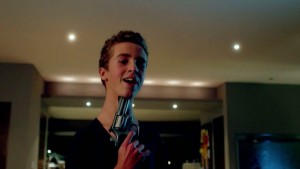Even if his early “body horror” films have now been canonized as classics (of a sort), and even if his more recent, less outre mainstream work has been often enthusiastically received, David Cronenberg has always been a divisive figure. This is more true of 2014’s Maps To The Stars than it has been in a while.
A Hollywood “satire” that he has implored people not to call a satire – a rule I will abide by from here on out – it’s a nasty, curious piece of work. It has, for instance, remarkably low ratings on Rotten Tomatoes, where phrases like “shallow,” “disappointing,” and (especially) “ugly” abound, and audiences don’t seem much more enthralled than the critics. It’s also far more interesting than either group grants, though more for structural and aesthetic than narrative reasons.
The narrative, from a script by Bruce Wagner, tracks several, mostly awful characters in an amoral and bankrupt Hollywood, doing things one might expect such people to do: taking meetings, angling for roles, writing scripts and pursuing acting gigs while driving a limo to pay the bills, getting caught up in generational cycles of incest, revenge, and suicidal purification rituals while fleeing the ghosts of dead children, drinking smoothies. Wait, what was that second-to-last one?
Julianne Moore (excellent and horrifying) is Havana Segrand, a famed actress now struggling to even get roles in middle age, ensconced in her luxurious mansion and attended to by new hire Agatha Weiss (Mia Waskowski), a burn victim with something of a troubled past. Benjie (Evan Bird) is a teen celebrity shitheel in a mock-Justin Bieber mold, who thinks himself gracious for giving out iPads to dying kids in the hospital on good will tours, while also getting their maladies wrong and berating his staff. John Cusack plays his dad, a cynical doctor/guru for hire, selling vomitous self-help volumes on the TV and offering transparently empty advice to his celebrity clients. Olivia Williams is his wife Christina, a brittle and, for most of the film, inscrutably damaged and worrying figure in the background.
Moore’s Segrand is up for the role of a lifetime – her own mother, a famous actress in her own right, who died during Segrand’s youth, also in a fire and perhaps after abusing her daughter. Themes of abuse, incest, fire, and water abound throughout the film, and it’s not surprising when all the narrative threads begin to tie together in deeply uncomfortable ways. We’re in Cronenberg territory, with or without the exploding heads, sexually penetrated leg wounds, and stomach vaginas that characterized so much of his early work.
What’s most interesting about Maps to the Stars, however, isn’t its shock factor (though Moore’s response to news of a toddler’s death, and its consequences for her career, has to be seen to be believed). For all its sometimes heavy-handed and “comic” attacks on Hollywood nastiness, the most striking thing is the disjunction between the tone of the script and Cronenberg’s approach to the material. As in films like Dead Ringers and Crash, there is a cold remove in the images and pacing, an almost anthropological dissection of the narrative. Wagner’s script burns hot with almost broad moments and ultra-heightened characterizations, but Cronenberg’s direction (and Howard Shore’s almost ambient score) takes the exact opposite path. In the Dissolve interview linked above, he emphasizes this point as well, quoting Truffaut’s line about “directing against the script.” It becomes increasingly disconcerting and uncanny as the film draws on.
Robert Pattinson also has another nice turn for the director, after his inspired performance in Cosmopolis (another terrific film none too pleasantly received in some quarters). From Stephen Lack in Scanners to Peter Weller in Naked Lunch or James Spader in Crash, Cronenberg likes his leading men affectless and slightly alien, and his new muse does that well here, too. He’s arguably the only likeable person in the film, yet he’s still a cypher and somehow fundamentally unknowable. By extension, the film seems to be saying, that seems the best Hollywood has to offer in terms of personalities, since everyone else is a monster.
Maps To The Stars closes on an almost mystical note, but it’s of a piece with everything that preceded it. This is a movie that’s hard to like, exactly – arcane, brutish, broad at some points and almost impossibly removed at others, thanks to the structural weirdness and cold aesthetic. It’s also extremely difficult to look away from it … I won’t say, “like a car crash,” but, you know, draw your own conclusions.
What’s clear is that the Canadian enfant terrible hasn’t mellowed with age, even if the shocks are less overt and the twisted bodies more in the soul than the flesh. Cronenberg isn’t done with his provocations, though, and that’s a very good thing.



